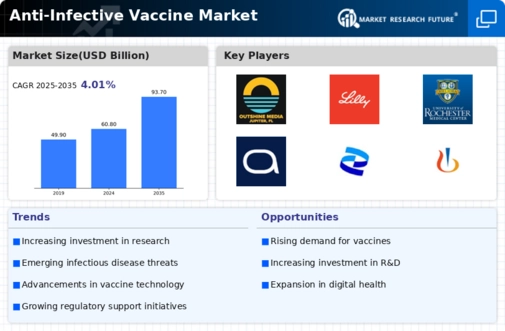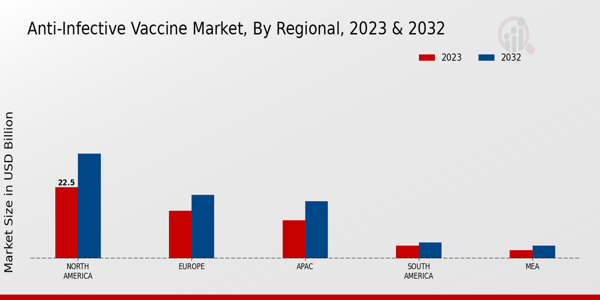Market Growth Projections
The Global Anti-Infective Vaccine Market Industry is poised for substantial growth, with projections indicating a market value of 60.8 USD Billion in 2024 and an expected increase to 93.7 USD Billion by 2035. This growth trajectory reflects a compound annual growth rate of 4.01% from 2025 to 2035. Such projections are indicative of the increasing demand for vaccines driven by factors such as rising disease prevalence, technological advancements, and government support. The market's expansion is likely to attract new entrants and foster competition, ultimately benefiting public health through improved vaccine availability and innovation.
Rising Global Disease Burden
The increasing prevalence of infectious diseases globally drives the Global Anti-Infective Vaccine Market Industry. As populations grow and urbanization expands, the incidence of diseases such as influenza, hepatitis, and tuberculosis rises. The World Health Organization indicates that infectious diseases remain a leading cause of mortality worldwide, necessitating effective vaccination strategies. This growing disease burden is expected to propel the market, with projections indicating a market value of 60.8 USD Billion in 2024. The urgency to develop and distribute vaccines to combat these diseases is likely to foster innovation and investment in the sector.
Government Initiatives and Funding
Government initiatives play a pivotal role in shaping the Global Anti-Infective Vaccine Market Industry. Many countries are increasing funding for vaccine research and development, recognizing the importance of immunization in public health. For instance, national vaccination programs and global partnerships aim to enhance vaccine accessibility and affordability. Such initiatives are crucial in combating infectious diseases, particularly in low- and middle-income countries. The commitment of governments to allocate resources towards vaccine development is expected to sustain market growth, with a projected compound annual growth rate of 4.01% from 2025 to 2035, reflecting the ongoing prioritization of public health.
Emergence of New Infectious Diseases
The emergence of new infectious diseases poses a significant challenge and opportunity for the Global Anti-Infective Vaccine Market Industry. As pathogens evolve and new strains emerge, the need for effective vaccines becomes increasingly urgent. The global health community is compelled to respond swiftly to these threats, leading to accelerated vaccine development processes. This dynamic environment fosters innovation and investment in vaccine research, as stakeholders recognize the potential for lucrative returns. The market's projected growth to 60.8 USD Billion in 2024 underscores the urgency of addressing these emerging infectious threats, highlighting the critical role of vaccines in global health security.
Growing Awareness of Preventive Healthcare
The rising awareness of preventive healthcare significantly impacts the Global Anti-Infective Vaccine Market Industry. As individuals become more informed about the benefits of vaccination, there is an increasing demand for vaccines that prevent infectious diseases. Public health campaigns and educational initiatives contribute to this awareness, emphasizing the importance of immunization in reducing disease transmission. This trend is likely to drive market growth, as more people seek vaccination as a proactive health measure. The anticipated growth in the market value to 93.7 USD Billion by 2035 suggests that this awareness will continue to shape consumer behavior and healthcare policies.
Technological Advancements in Vaccine Development
Innovations in vaccine technology significantly influence the Global Anti-Infective Vaccine Market Industry. Advances such as mRNA technology and viral vector platforms enhance the efficacy and safety profiles of vaccines. These technologies allow for rapid development and deployment of vaccines, which is crucial in addressing emerging infectious threats. The market is projected to reach 93.7 USD Billion by 2035, reflecting the impact of these advancements. Furthermore, the integration of artificial intelligence in vaccine research and development may streamline processes, reduce costs, and improve outcomes, thereby attracting further investment and interest in the anti-infective vaccine sector.






















